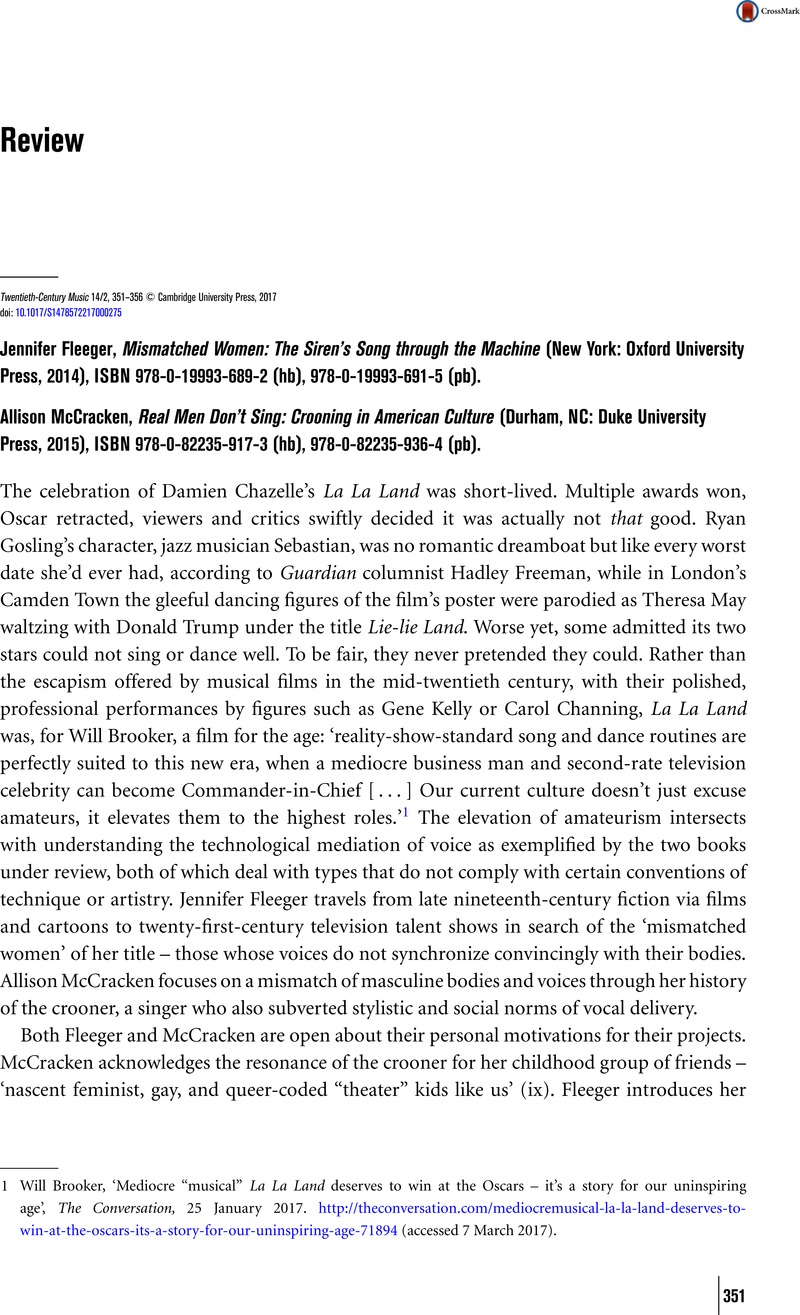No CrossRef data available.
Article contents
Jennifer Fleeger , Mismatched Women: The Siren's Song through the Machine (New York: Oxford University Press, 2014), ISBN 978-0-19993-689-2 (hb), 978-0-19993-691-5 (pb). - Allison McCracken , Real Men Don't Sing: Crooning in American Culture (Durham, NC: Duke University Press, 2015), ISBN 978-0-82235-917-3 (hb), 978-0-82235-936-4 (pb).
Published online by Cambridge University Press: 25 July 2017
Abstract

- Type
- Reviews
- Information
- Copyright
- Copyright © Cambridge University Press, 2017
References
1 Will Brooker, ‘Mediocre “musical” La La Land deserves to win at the Oscars – it's a story for our uninspiring age’, The Conversation, 25 January 2017. http://theconversation.com/mediocremusical-la-la-land-deserves-to-win-at-the-oscars-its-a-story-for-our-uninspiring-age-71894 (accessed 7 March 2017).
2 No matter that Lind's personal life was not necessarily chaste: an affair with another symbol of Victorian purity, Felix Mendelssohn, has even been rumoured: see Biddlecombe, George, ‘Secret Letters and a Missing Memorandum: New Light on the Personal Relationship between Felix Mendelssohn and Jenny Lind’, Journal of the Royal Musical Association 138/1 (2013), 47–83.CrossRefGoogle Scholar
3 Her primary references are to Silverman's, Kaja discussion of the treatment of silent film star Lina Lamont in Singin’ in the Rain (1952) in The Acoustic Mirror: The Female Voice in Psychoanalysis and Cinema (Bloomington: Indiana University Press, 1987), 42–71Google Scholar; and Ann Doane's, Mary ‘The Voice in the Cinema: The Articulation of Body and Space’, Yale French Studies 60 (1980), 33–50 Google Scholar.
4 See his articles ‘The Material Heterogeneity of Recorded Sound’ and ‘Sound Space’ in Sound Theory/Sound Practice, ed. Rick Altman (New York: Routledge, 1992), 15–34, 46–64.
5 See, for instance, Sun Eidsheim, Nina, Sensing Sound: Singing and Listening as Vibrational Practice (Durham, NC: Duke University Press, 2015)CrossRefGoogle Scholar.
6 It is a shame there is no reference to Martha Feldman's or James Q. Davies's work on the castrato, which would have helped nuance the historical narrative. See Feldman, Martha, ‘Denaturing the Castrato’, The Opera Quarterly 24/3–4 (2008), 178–99Google Scholar; and Davies, James Q., ‘Veluti in Speculum: The Twilight of the Castrato’, Cambridge Opera Journal 17/3 (2005), 271–301 Google Scholar. Both authors have published related books which postdate the volume under review: see Feldman, The Castrato: Reflections on Natures and Kinds (Berkeley: University of California Press, 2015)Google Scholar; and Davies, Romantic Anatomies of Performance (Berkeley: University of California Press, 2014)Google Scholar.
7 For more on singers’ relationship to motherhood, see Rutherford, Susan, The Prima Donna and Opera, 1815–1930 (Cambridge: Cambridge University Press, 2006)Google Scholar.




